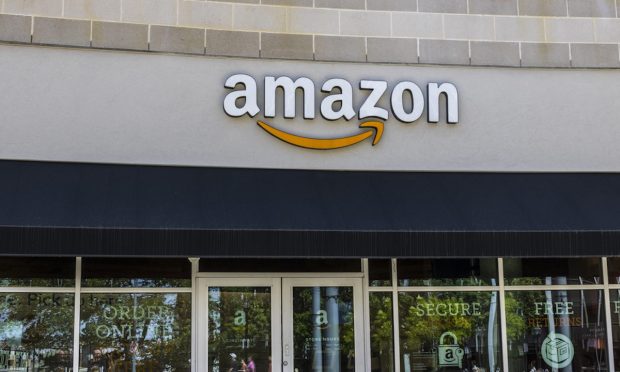AMZN vs. WMT Weekly: Omnichannel Boosts Walmart Earnings; Amazon Signals It’s All-In On Brick-and-Mortar

In a battle that has thus far been primarily fought across a digital landscape, Amazon this week appeared to be taking its rivalry with Walmart to the physical realm, with news that it plans to open department store-style physical locations in the coming years.
The physical Amazon retail stores in Ohio and California will initially average about 30,000 square feet, which is a fraction of the typical 100,000 square feet that department stores typically occupy and smaller than the 187,000-square-foot size of an average Walmart Supercenter.
See also: Amazon Hatching Strategy To Open Mega Brick-and-Mortar Stores
Though an Amazon spokesperson told PYMNTS that the company does not comment on rumors or speculation, retail executives and industry watchers clearly see this as the eCommerce giant working to solidify its hold on consumers’ wallets as it creeps ever closer to overtaking Walmart as the No. 1 retailer in the U.S.
Brian Walker, chief strategy officer at digital experience platform Bloomreach, said in an email that the department store plans are “no doubt still very much an experiment at this stage,” but is a move toward cementing Amazon as a consumer brand and bringing its last-mile fulfillment ever closer to consumers.
“And, of course, they can do this while capitalizing on the very challenged big-box retail real estate market, for very cost-efficient and flexible leases, to further experiment with physical stores,” Walker added.
Kunal Chopra, CEO of eCommerce software company Kaspien, told PYMNTS that Amazon’s plans are a testament to its agility, “and sets the stage for the future of retail and eCommerce.” Chopra also noted that there may be an opportunity for individual sellers on Amazon’s marketplace, though the company is sure to be highly selective about the brands and products it places in-store.
“While it will be difficult to earn Amazon’s blessing to grace department store shelves, it presents a tremendous opportunity for sellers to diversify their own selling strategies,” he said.
Since Amazon posted a rare quarterly earnings miss last month, its stock has fallen by nearly 10 percent, compared to the 3 percent rise of the S&P 500 over the same time period. It showed little movement even after The Wall Street Journal broke the department store news Thursday morning (Aug. 19).
Walmart’s Omnichannel Success
The news likely took the wind out of Walmart’s sails after earlier this week it celebrated higher-than-expected revenue on the back of its omnichannel approach, which simultaneously helped neutralize decelerating eCommerce sales while still catering to consumers shopping online.
Related news: Walmart Tells Shoppers ‘We’re Here For You’ As Omnichannel Retailer Neutralizes Delta Variant
Officially, Walmart’s total revenue in the second quarter was $141 billion, up 2.4 percent year over year, with net sales of nearly $140 billion, up 2.2 percent. In the U.S., Walmart saw just over $98 billion in net sales, up 5.3 percent, and a 6 percent growth in eCommerce sales.
CEO Doug McMillon said Walmart’s global eCommerce sales are on track to reach $75 billion by the end of the year. For the full fiscal year, Walmart is expecting comp sales of 5 percent to 6 percent, representing about $20 billion of growth.
While McMillon noted that Walmart’s business overall is becoming more digital and focused on omnichannel as the mindset across the company changes, Amazon’s new department store plans make it clear that Walmart is running out of time as the top retailer in the U.S. Still, Walmart’s Chief Financial Officer Brett Biggs said he’s confident in the box store giant.
“Almost six years ago now, we talked about how we need to take the opportunity to invest in wages and eCommerce, and we were a little bit behind where we wanted to be in some areas,” Biggs said. “And now, when we invest, it feels very offensive.”
Preparing for Potential Regulation
Amazon is reportedly warning third-party retailers on its marketplace that potential antitrust rules being considered by Congress could harm them, sending letters and offering phone consultations to merchants about the legislation and its effects.
Previously reported: Amazon Warns Sellers About Congressional Antitrust Push
Though details about what would happen in said phone calls were unavailable, an email viewed by CNBC says that Amazon is reaching out “to a small group of our sellers” to make them aware of the legislative proposals. “It is early in the process and the bills are subject to change, but we are concerned that they could potentially have significant negative effects on small and medium-sized businesses like yours that sell in our store,” the email reads.
The legislation in question, which was green-lighted by a House Judiciary Committee in June, consists of several measures to try and cut down on the power of Big Tech.
Lawmakers have also asked Amazon to provide details about privacy and security protections for its new Amazon One palm-print recognition system, which is used by customers to verify their identities while making purchases at brick-and-mortar locations such as Whole Foods and Amazon retail stores.
See: US Senators Press Amazon On Palm-Recognition Security
Three senators — two Democrats and one Republican — have asked the eCommerce giant to provide written answers by Thursday to a slew of questions on topics such as expansion plans for the technology, the number of third parties given access to the data and what steps Amazon has taken to protect biometric data.
More Pressure on Grocery
Of course, the AMZN vs. WMT Weekly feature wouldn’t be complete without a mention of groceries, and this week is no exception. In its earnings report, Walmart said its share of the U.S. grocery market grew in the second quarter, with comp sales up 6 percent compared to last year. On a two-year stacked basis, grocery sales increased by low single digits; they currently make up over half of all sales made by Walmart.
Just days before Walmart executives began patting themselves on the back, though, Albertsons said it will overhaul its digital offerings with a new app, a new loyalty program and a new eGrocery subscription service that challenges Amazon Prime and Walmart+. Albertsons’ FreshPass costs $99 a year or $12.99 for a single month, and members receive free delivery for orders totaling more than $30.
Read more: Albertsons Takes On Walmart, Amazon With New eGrocery Subscription
In a memo leaked earlier this year, Walmart expressed concern about its shrinking grocery share, pointing to Albertsons, Publix and Target, among others, as the culprits, alongside statistics showing increasing customer traffic at those chains and a decline at Walmart.
Indeed, even though Target’s grocery business is an order of magnitude smaller than that of Walmart, Target saw low double-digit grocery growth in the second quarter, driven by improvements in the retailer’s curbside pickup program. Shipt, Target’s grocery-delivering Instacart competitor, grew about 20 percent year over year, following 60 percent growth in 2020.
More: Drive Up Drives Grocery Sales At Target With 2x Growth Over Walmart
